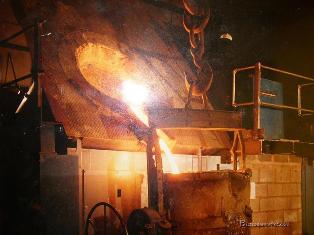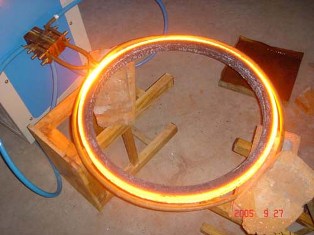Classification of electrical installations
Electrotechnological processes are widely used in industry. The equipment for these processes is very diverse in terms of the principle of operation, power, characteristics of electricity consumption.
Electrical equipment includes: electric furnaces and electric heating installations, electric welding installations of all types, installations for dimensional electrophysical and electrochemical processing of metals. Accordingly, the concept "Electrotechnologies" includes the following technological processes and methods of processing materials:
-
electrothermal processes, in which the conversion of electrical energy into heat is used to heat materials and products in order to change their properties or form, as well as for their melting and vaporization; — electric welding processes in which thermal energy obtained from electric energy is used to heat bodies in order to make a permanent connection with the provision of direct continuity at the welding point;
-
electrochemical methods for processing and obtaining materials, in which the decomposition of chemical compounds and their separation is carried out with the help of electrical energy by moving charged particles (ions) in a liquid medium under the action of an electric field (electrolysis, galvanization, anodic electrochemical processing) ;
-
electrophysical processing methods, in which the transformation of electrical energy into mechanical and thermal (electroerosive, ultrasonic, magnetic pulses, electroexplosive) is used to affect materials;
-
aerosol technology in which the energy of an electric field is used to impart an electric charge to fine particles of matter suspended in the gas stream to move under the action of the field in the desired direction.
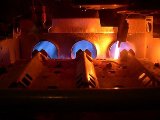 The term "Industrial electrical installations and equipment" includes nodes in which electrical processes are carried out, as well as auxiliary electrical equipment and devices (power supplies, protection, control devices, etc.).
The term "Industrial electrical installations and equipment" includes nodes in which electrical processes are carried out, as well as auxiliary electrical equipment and devices (power supplies, protection, control devices, etc.).
Electric heating is widely used in industrial enterprises in the production of molded castings of metals and alloys, heating of blanks before pressure treatment, heat treatment of parts and assemblies of electrical machines, drying of insulating materials, etc.
An electrothermal installation is called a complex consisting of electrothermal equipment (an electric furnace or an electrothermal device in which electrical energy is converted into thermal energy), and electrical, mechanical and other equipment that ensures the execution of the work process in the installation.
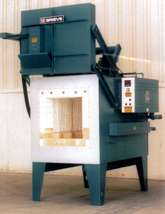
1.Very simple and accurate implementation of the set temperature mode.
2. Ability to concentrate large power in a small volume.
3. Achieving high temperatures (3000 ° C and higher compared to 2000 ° with fuel heating).
4. Possibility of obtaining high uniformity of the thermal field.
5. Absence of influence of gases on the processed product.
6. Possibility of processing in a favorable environment (inert gas or vacuum).
7. Low consumption of alloying additives.
8. High quality of the obtained metals.
nine. Easy mechanization and automation of electrothermal installations.
10. Ability to use production lines.
11. The best working conditions for service personnel.
Disadvantages of electric heating: more complex structure, high installation costs and the resulting heat energy.
Electrothermal equipment is very diverse in principle of operation, design and purpose. In general, all electric furnaces and electrothermal devices can be divided according to their purpose into melting furnaces for melting or reheating molten metals and alloys and thermal (heating) furnaces and devices for heat treatment, metal products, heating materials for plastic deformation , drying products, etc.
According to the method of converting electrical energy into heat, they distinguish in particular rFurnaces and resistance devices, arc furnaces, induction furnaces and devices.
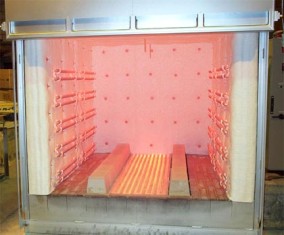
Resistance heating furnace
Classification of electrothermal installations
1. By the method of converting electricity into heat.
1) Installations with heated current with active resistance.
2) Induction installations.
3) Arc installations.
4) Installations of dielectric heating.
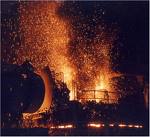
1) Direct heating (heat is generated directly in the products)
2) Indirect heating (heat is released in the heater or in the interelectrode gap of the electric arc.
3. By construction characteristics.
4. With advance registration.
V electric furnaces and electrothermal resistance devices the release of heat by electric current is used when it passes through solids and liquids. Electric furnaces of this type are mainly implemented as furnaces with indirect heating.
The conversion of electricity into heat in them takes place in a solid heating elements, from which heat is transferred to the heated body by radiation, convection and heat conduction, or in a liquid heat carrier — molten salt, in which the heated body is immersed, and heat is transferred to it by convection and heat conduction. Resistance furnaces are the most common and diverse type of electric furnace.
Resistance melting furnaces are mainly used in the production of castings from low-melting metals and alloys.
Work electric arc melting furnaces based on the release of heat in an arc discharge. The electric arc concentrates a lot of energy and develops a temperature above 3500 ° C.
V arc furnaces with indirect heating the arc burns between the electrodes and the heat is transferred to the molten body mainly by radiation. Furnaces of this type are used in the production of castings from non-ferrous metals, their alloys and cast iron.
V direct heating arc furnaces one of the electrodes is the melting body itself.These furnaces are designed for melting steel, refractory metals and alloys. In direct arc furnaces, most of the steel for die casting is melted.
V induction furnaces and devices heat in an electrically conductive heated body is released by currents induced in it by an alternating electromagnetic field. In this way, direct heating takes place here.
An induction furnace or device can be thought of as a type of transformer in which the primary coil (inductor) is connected to an alternating current source and the heated body itself serves as the secondary coil. Induction melting furnaces are used in the production of castings, including shaped, from steel, cast iron, non-ferrous metals and alloys.
Induction heating furnaces and installations it is used to heat workpieces for plastic deformation and for various types of heat treatment. Induction thermal devices are used for surface hardening and other specialized operations.

